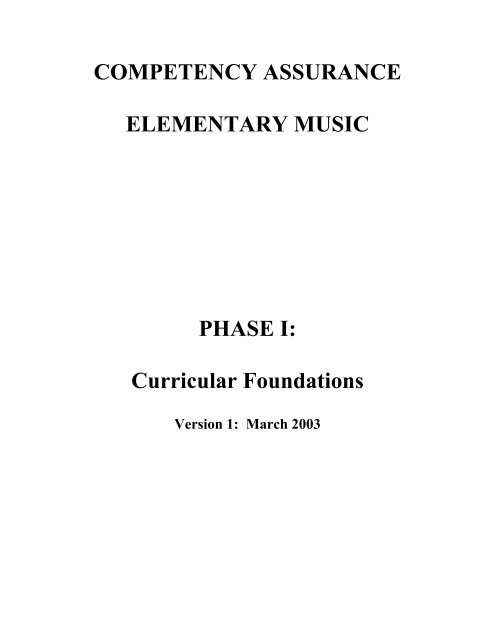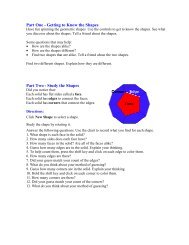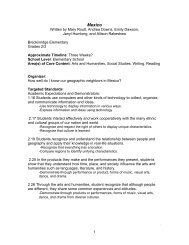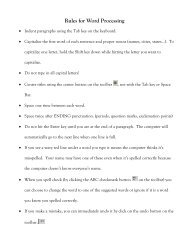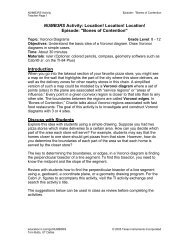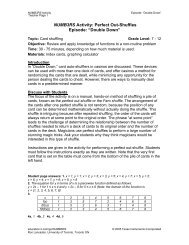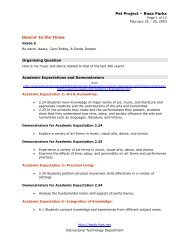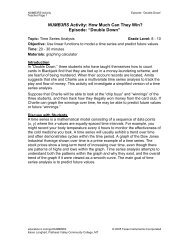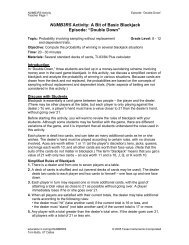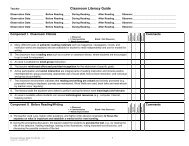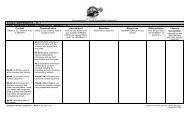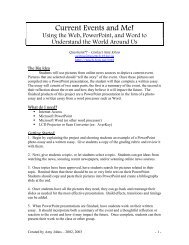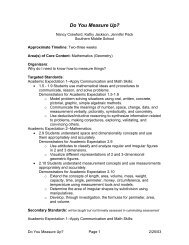Download All Elementary Music Standards (PDF) - FCPS ...
Download All Elementary Music Standards (PDF) - FCPS ...
Download All Elementary Music Standards (PDF) - FCPS ...
Create successful ePaper yourself
Turn your PDF publications into a flip-book with our unique Google optimized e-Paper software.
COMPETENCY ASSURANCEELEMENTARY MUSICPHASE I:Curricular FoundationsVersion 1: March 2003
Competency AssurancePhase I:Curricular FoundationsThis document is designed to help teachers make certain that they are teaching abalanced curriculum in line with the standards and assessments required by theCommonwealth of Kentucky and the Fayette County Public Schools.Each page contains the appropriate Performance <strong>Standards</strong>, taken from TheProgram of Studies; Academic Expectations and Demonstrators, taken fromthe Transformations document; curricular content and Specific Activities takenfrom the Core Content For Assessment; as well as Suggested Activities andCritical Vocabulary as designed by music teachers in the Fayette County PublicSchools.It is hoped that this document will allow teachers to work from one comprehensivedocument that brings together all the state-mandated and suggested curricularstandards. It is also hoped that the suggested activities will give teachers a sense ofthe kinds of activities necessary for them to achieve the stated academic goals.Please note: Although this document limits itself to concepts and skillscovered in the Core Content For Assessment, there are several items that havebeen identified as appropriate “extensions” that might be approached uponcompletion of the required materials. In this document those extensions areidentified by italics.2
COMPETENCY ASSURANCEELEMENTARY MUSICTable of ContentsIntroduction ……………………………………………….2Kindergarten Elements …………………………………..……4Kindergarten Historical/Cultural Context ………………..……5First Grade Elements …………………………………..………6First Grade Historical/Cultural Context …………………..……7Second Grade Elements ……………………………….……..…8Second Grade Historical/Cultural Context ……………..………10Third Grade Elements …………………………………..…...…11Third Grade Historical/Cultural Context ………………..…..…13Fourth Grade Elements …………………………………………15Fourth Grade Historical/Cultural Context ………………..….…17Fifth Grade Elements ………………………….……………..…19Fifth Grade Historical/Cultural Context ………………………..213
PRIMARY MUSIC: KINDERGARTEN // ELEMENTSPROGRAM OF STUDIES:Performance StandardStudents respond with minimal attention given to the element of music. (rhythm, melody, form, harmony,timbre, dynamics, tempo)Performance Standard:Students begin to demonstrate an awareness of the elements of musicACADEMIC EXPECTATION(S):1.14 – Students construct meaning and/or communicate ideas and emotions through music2.22 – Students create products and make presentations that convey concepts and feelingsin the human experience through their productions, performance, or interpretationsCore Content for Assessment:AH-E-1.1.31 Rhythm: steady beatAH-E-1.1.32 Tempo: slow, fastAH-E-1.1.33 Melody: shape, direction (up,down, same, step, skip), high vs. low notes(pitches)AH-E-1.1.36 Timbre: Sounds of voicesAH-E-1.1.37 Dynamics: soft (piano), loud(forte)Demonstrators:• Explore and respond to music through singing,instrument playing, moving, listening andcreating.• Experience and perform music from diversecultures.• Explore the elements and principles of musicalforms• Create or perform original or existing musicSpecific Activities:• AH-E-1.1.12 – Create and notate short, simple melodies that demonstrate melodic shape/contourand meter• AH-E-1.1.23 – Sing rote melodies accuratelySuggested Activities:• Singing age-appropriate songs• Clapping, patting, moving to the steady beat• Performing rhythmic accompaniments on sticks, rhythm instruments, body percussion• Echoing and pitch modeling activities• Directed listening with focus on elements• Recognizing and using appropriate “voices” (Whispering, speaking, singing, shouting)Critical Vocabulary:Steady beat, slow, fast, melody (up, down, same, high, low), loud, soft, long and short4
PRIMARY MUSIC: KINDERGARTEN // HISTORICAL/CULTURAL CONTEXTPROGRAM OF STUDIES:Performance Standard:Students listen to music of diverse cultures, periods, and stylesPerformance Standard:Students experience music of diverse cultures, periods and stylesACADEMIC EXPECTATION(S):1.14 – Students construct meaning and/or communicate ideas and emotions through music2.24 – Students appreciate creativity and the values of the arts and the humanities2.26 – Students recognize differences and commonalities in the human experience through theirproductions, performances or interpretationsCore Content for Assessment:AH-E-1.2.31 – Identify American folk musicAH-E-1.2.32 – Discuss game songs, lullabiesDemonstrators:• Explore a variety of art forms in music• Experience and perform a variety of art forms inmusic from diverse cultures• Express openness to differences andcommonalities among diverse culturesSpecific Activities:• AH-E-1.1.23 – Sing rote melodies accurately• AH-E-1.1.25 – Recognize and demonstrate the relationship between elements of music andexpressive qualities of movementSuggested Activities:• Students listen to songs and music of other cultures (SSC – Matches Social Studies Curriculum)• Students sing songs of other cultures (SSC)• Students listen to and sing age-appropriate traditional American folk songs (SSC)• Students listen to or sings holiday music, both traditional American and from other cultures (SSC)• Students listen to or sing music that relates to seasons (SSC)• Students move to music from many culturesCritical Vocabulary:Culture, game songs, songs, lullabies5
PRIMARY MUSIC: FIRST GRADE // HISTORICAL/CULTURAL CONTEXTPROGRAM OF STUDIES:Performance Standard:Students listen to music of diverse cultures, periods, and stylesPerformance Standard:Students experience music of diverse cultures, periods and stylesACADEMIC EXPECTATION(S):1.14 – Students construct meaning and/or communicate ideas and emotions through music2.24 – Students appreciate creativity and the values of the arts and the humanities2.26 – Students recognize differences and commonalities in the human experience through theirproductions, performances or interpretationsCore Content for Assessment:AH-E-1.2.31 – Identify American folk musicAH-E-1.2.32 – Discuss game songs, lullabies,patriotic songs, marchesDemonstrators:• Explore a variety of art forms in music• Experience and perform a variety of art forms inmusic from diverse cultures• Express openness to differences andcommonalities among diverse culturesSpecific Activities:• AH-E-1.1.23 – Sing rote melodies accurately• AH-E-1.1.25 – Recognize and demonstrate the relationship between elements of music andexpressive qualities of movementSuggested Activities:• Students listen to songs and music of other cultures (SSC – Matches Social Studies Curriculum)• Students sing songs of other cultures (SSC)• Students listen to and sing age-appropriate traditional American folk songs (SSC)• Students listen to or sings holiday music, both traditional American and from other cultures (SSC)• Students listen to or sing music that relates to seasons (SSC)• Students move to music from many cultures• Students sing patriotic songs (SSC)• Students move to marches (SSC)Critical Vocabulary:Culture, American Folk culture; game songs, folk songs, work songs, lullabies, patriotic songs, marches7
PRIMARY MUSIC: SECOND GRADE // ELEMENTSPROGRAM OF STUDIES:Performance StandardStudents recognize the elements of musicPerformance Standard:Students begin to recognize terminology, notation, and symbols within the elements of musicACADEMIC EXPECTATION(S):1.14 – Students construct meaning and/or communicate ideas and emotions through music2.22 – Students create products and make presentations that convey concepts and feelingsin the human experience through their productions, performance, or interpretationsCore Content for Assessment:AH-E-1.1.31 Rhythm: steady beat, meter(duple, triple), time signatures (2/4, 3/4, 4/4),rhythmic durations (half, quarter, 8 th notes andrests), fermataAH-E-1.1.32 Tempo: slow, fastAH-E-1.1.33 Melody: shape, direction (up,down, same, step, skip) high vs. low notes(pitches), lines and spacesAH-E-1.1.35 Form: call & response, two-part(AB), three-part (ABA), verse/chorus, repeatsignsAH-E-1.1.36 Timbre: sounds of voices andinstrument familiesAH-E-1.1.37 Dynamics: soft (piano), loud(forte)Demonstrators:• Explore and respond to music through singing,instrument playing, moving, listening andcreating• Experience and perform music from diversecultures• Explore the elements and principles of art forms• Create and/or perform original and existingworks of music• Discuss works of art using appropriate conceptsand terminologySpecific Activities:• AH-E-1.1.11 – Create and notate short, simple melodies that demonstrate melodic shape/contourand meter• AH-E-1.1.12 – Create simple melodic or rhythmic accompaniments to given melodies• AH-E-1.1.13 – Improvise answers in similar style to given rhythmic and/or melodic phrases• AH-E-1.1.22 – Perform simple rhythmic, melodic or chordal patterns on classroom instruments• AH-E-1.1.23 – Sing rote melodies accuratelySuggested Activities:• Singing age-appropriate songs• Clapping, patting, moving to the steady beat• Performing rhythmic accompaniments on sticks, rhythm instruments, body percussion• Performing simple ostinato accompaniments on classroom instruments• Creating melodies that demonstrate “shape” with voices or on classroom instruments• Directed listening with focus on elements• Identifying simple forms• Creating pieces in simple forms• Recognizing voices as “high” or “low”8
Suggested Activities Continued:• Visual recognition of instruments• Aural recognition of instruments by familiesCritical Vocabulary:Rhythm (steady beat); tempo slow, fast; melody (up, down, same, step, skip, high, low); form, call &response, verse, chorus; dynamics, loud (forte), soft (piano), quarter note, quarter rest, eighth note, halfnote, half rest, fermata9
PRIMARY MUSIC: SECOND GRADE // HISTORICAL/CULTURAL CONTEXTPROGRAM OF STUDIES:Performance Standard:Students listen to music of diverse cultures, periods, and stylesPerformance Standard:Students experience music of diverse cultures, periods and stylesPerformance Standard:Students use simple music terminology when describing music of diverse cultures, purposes and stylesACADEMIC EXPECTATION(S):1.14 – Students construct meaning and/or communicate ideas through music2.24 – Students appreciate creativity and the values of the arts and the humanities2.26 – Students recognize differences and commonalities in the human experience through theirproductions, performances or interpretationsCore Content for Assessment:AH-E-1.2.31 – Identify similarities anddifferences in musical elements used in themusic of Native Americans and American folkmusicAH-E-1.2.32 – Discuss game songs, folksongs, work songs, lullabies, patriotic songs,marchesDemonstrators:• Explore a variety of art forms in music• Experience and perform a variety of art forms inmusic from diverse cultures• Express openness to differences andcommonalities among diverse cultures• Describe reaction to artworks and performancesusing basic vocabulary• Respond to the expressive qualities of musicSpecific Activities:• AH-E-1.1.12 – Create simple melodic or rhythmic accompaniments to given melodies• AH-E-1.1.23 – Sing rote melodies accurately• AH-E-1.1.25 – Recognize and demonstrate the relationship between elements of music andexpressive qualities of movementSuggested Activities:• Students listen to songs and music of other cultures (SSC – Matches Social Studies Curriculum)• Students sing songs of other cultures (SSC)• Students listen to and sing age-appropriate traditional American folk songs (SSC)• Students listen to or sings holiday music, both traditional American and from other cultures (SSC)• Students create accompaniments to music from many cultures on age-appropriate instruments(SSC)• Students move to music from many cultures• Students sing patriotic songs (SSC)• Students Listen to and move to marches (SSC)• Students listen to Native American music (SSC)• Students sing Native American songs (SSC)Critical Vocabulary:Culture, American Folk culture, Native American; game songs, folk songs, work songs, lullabies, patrioticsongs, marches10
PRIMARY MUSIC: THIRD GRADE // ELEMENTSPROGRAM OF STUDIES:Performance Standard:Students recognize the elements of musicPerformance Standard:Students begin to recognize terminology, notation, and symbols within the elements of musicPerformance Standard:Students identify and discuss the elements of musicPerformance Standard:Students interpret and use terminology, notation, and symbols within the elements of musicACADEMIC EXPECTATION(S):1.14 – Students construct meaning and/or communicate ideas and emotions through music2.22 – Students create products and make presentations that convey concepts and feelingsin the human experience through their productions, performance, or interpretations2.23 - Students analyze their own and others’ artistic products and performancesCore Content for Assessment:AH-E-1.1.31 Rhythm: steady beat, meter(duple, triple), time signatures (2/4, 3/4, 4/4),rhythmic durations (whole, half, quarter, 8 thnotes and rests), fermataAH-E-1.1.32 Tempo: slow, fast, mediumAH-E-1.1.33 Melody: shape, direction (up,down, same, step, skip) high vs. low notes(pitches), lines and spaces, treble clef sign,pitch notation (middle C to F at top of staff)AH-E-1.1.34 Harmony: unison, parts, tonality(major, minor, resting), intervalsAH-E-1.1.35 Form: call & response, two-part(AB), three-part (ABA), verse/chorus, repeatsigns, roundAH-E-1.1.36 Timbre: sounds of individualvoices and instruments, instrument families,AH-E-1.1.37 Dynamics: soft (piano), loud(forte), medium soft (mezzo piano), mediumloud (mezzo forte), very loud (fortissimo), verysoft (pianissimo),crescendo/decrescendoDemonstrators:• Explore and respond to music through singing,instrument playing, moving, listening, reading,writing and creating• Experience and perform music from diversecultures• Recognize and develop music concepts(melody, harmony, rhythm, form expression, andstyle)• Recognize and demonstrate arts concepts usedto describe feelings• Create and/or perform original and existingworks of music• Discuss works of art using appropriate conceptsand terminology• Observe and explore a variety of artistic stylesand forms in musicSpecific Activities:• AH-E-1.1.11 – Create and notate short, simple melodies that demonstrate melodic shape/contourand meter• AH-E-1.1.12 – Create simple melodic or rhythmic accompaniments to given melodies• AH-E-1.1.13 – Improvise answers in similar style to given rhythmic and/or melodic phrases• AH-E-1.1.21 – Sing and play alone simple rhythmic or tonal patterns by reading music notation.Be able to sustain own part in an ensemble• AH-E-1.1.22 – Perform simple rhythmic, melodic or chordal patterns on classroom instruments11
Specific Activities Continued:• AH-E-1.1.23 – Sing rote melodies accurately• AH-E-1.1.24 – Evaluate own musical performance or composition by citing appropriate musicalelementsSuggested Activities:• Singing age-appropriate songs using the terms “unison” and “parts”• Performing rhythmic accompaniments on sticks, rhythm instruments, body percussion• Performing rhythmic, melodic or chordal patterns on classroom instruments• Reading simple rhythms• Creating melodies that demonstrate “shape” with voices or on classroom instruments• Improvising answers in similar style of given rhythmic and/or melodic phrases• Directed listening with focus on elements• Identifying simple forms• Creating pieces in simple forms• Recognizing voices as “high” or “low”• Visual recognition of instruments• Aural recognition of instruments by families• Identifying and creating pieces with changing dynamicsCritical Vocabulary:Rhythm (steady beat); tempo slow, fast, medium; melody (up, down, same, step, skip, high, low); form,call & response, verse, chorus, round; dynamics, loud (forte), soft (piano), medium loud (mezzo forte),medium soft (mezzo piano), very loud (fortissimo), very soft (pianissimo) crescendo, decrescendo;unison; parts; tonality, major, minor, “resting tonality”; treble clef, intervals12
PRIMARY MUSIC: THIRD GRADE // HISTORICAL/CULTURAL CONTEXTPROGRAM OF STUDIES:Performance Standard:Students listen to music of diverse cultures, periods, and stylesPerformance Standard:Students experience music of diverse cultures, periods and stylesPerformance Standard:Students use simple music terminology when describing music of diverse cultures, purposes and stylesPerformance Standard:Students develop an awareness that specific styles of music define time periods and respective culturesPerformance Standard:Students identify music from diverse cultures, periods and stylesACADEMIC EXPECTATION(S):1.14 – Students construct meaning and/or communicate ideas through music2.22 – Students create products and make presentations that convey concepts and feeling in the humanexperience through their productions, performance or interpretations2.23 – Students analyze their own and others’ artistic products and performances2.24 – Students appreciate creativity and the values of the arts and the humanities2.25 – Through their productions and performances or interpretation, students show an understanding ofthe influence of time, personality and society on the arts and humanities2.26 – Students recognize differences and commonalities in the human experience through theirproductions, performances or interpretationsCore Content for Assessment:AH-E-1.2.31 – Identify similarities anddifferences in musical elements used in themusic of Native Americans, West African andAmerican folk musicAH-E-1.2.32 – Discuss game songs, folksongs, work songs, lullabies, marches,patriotic songs, spirituals, and bluesDemonstrators:• Explore and respond to music through singing,instrument playing, moving, listening, reading,writing and creating• Recognize and develop music concepts(melody, harmony, rhythm, form, expression,and style)• Explore a variety of art forms in music• Experience and perform a variety of art forms inmusic drama from diverse cultures• Create and/or perform original and existingworks of music• Describe reaction to artworks and performancesusing basic vocabulary• Express openness to differences andcommonalities among diverse cultures.• Communicate recognition of the diversity of artforms and structure in music• Respond to the expressive qualities of music• Recognize and demonstrate arts concepts usedto describe feelings• Recognize the role of the artist in music13
Specific Activities:• AH-E-1.1.12 – Create simple melodic or rhythmic accompaniments to given melodies• AH-E-1.1.13 – Improvise answers in similar style to given rhythmic and/or melodic phrases• AH-E-1.1.21 – Sing and play alone simple rhythmic or tonal patterns by reading music notation.Be able to sustain own part in an ensemble• AH-E-1.1.22 – Perform simple rhythmic, melodic or chordal patterns on classroom instruments• AH-E-1.1.23 – Sing rote melodies accurately• AH-E-1.1.24 – Evaluate own musical performance or composition by citing appropriate musicalelements• AH-E-1.1.25 – Recognize and demonstrate the relationship between elements of music andexpressive qualities of movementSuggested Activities:• Listening to, singing and/or writing about songs and music of other cultures (SSC – MatchesSocial Studies Curriculum)• Listening to, singing and/or writing about age-appropriate traditional American folk songs (SSC)• Listening to, singing and/or writing about holiday music, both traditional American and from othercultures (SSC)• Creating accompaniments to music from many cultures on age-appropriate instruments (SSC)• Moving to and/or writing about music from many cultures• Singing and/or writing about patriotic songs (SSC)• Listening to, moving to and/or writing about marches (SSC)• Listening to and writing about Native American music (SSC)• Singing and/or writing about Native American songs (SSC)• Listen to and writing about West African music (SSC)• Singing and/or writing about West African Songs (SSC)• Playing and/or writing about West African games and instruments (SSC)Critical Vocabulary:Culture, American Folk culture, Native American, West African; game songs, folk songs, work songs,lullabies, patriotic songs, marches; spirituals, blues14
PRIMARY MUSIC: FOURTH GRADE // ELEMENTSPROGRAM OF STUDIES:Performance Standard:Students use elements of music (rhythm, melody, form, timbre, harmony, tempo, dynamics) whileperforming, singing, instrument playing, moving, listening, reading, writing and creatingPerformance Standard:Students will recognize and develop music elementsPerformance Standard:Students will use appropriate terminology to describe the purpose of music elementsPerformance Standard:Students use developmentally appropriate performance techniques, practices, and music elements tocommunicate ideas and emotionsACADEMIC EXPECTATION(S):1.14 – Students construct meaning and/or communicate ideas and emotions through music2.22 – Students create products and make presentations that convey concepts and feelingsin the human experience through their productions, performance, or interpretations2.23 - Students analyze their own and others’ artistic products and performanceCore Content for Assessment:AH-E-1.1.31 Rhythm: steady beat, meter(duple, triple), time signatures (2/4, 3/4, 4/4),rhythmic durations (whole, half, quarter, 8 thnotes and rests), fermataAH-E-1.1.32 Tempo: slow (largo), medium(moderato), fast (allegro)AH-E-1.1.33 Melody: shape, direction (up,down, same, step, skip) high vs. low notes(pitches), lines and spaces, treble clef sign,pitch notation (middle C to F at top of staff)AH-E-1.1.34 Harmony: unison, parts, tonality(major, minor, resting), intervalsAH-E-1.1.35 Form: call & response, two-part(AB), three-part (ABA), verse/chorus, repeatsigns, round, rondoAH-E-1.1.36 Timbre: sounds of individualvoices and instruments, instrument families,AH-E-1.1.37 Dynamics: piano, forte, mezzopiano, mezzo forte, fortissimo, pianissimo,crescendo/decrescendoDemonstrators:• Explore and respond to music through singing,instrument playing, moving, listening, reading,writing and creating• Experience and perform music from diversecultures• Recognize and develop music concepts(melody, harmony, rhythm, form expression, andstyle)• Discuss musical using appropriate concepts andterminology• Create and/or perform original and existingworks of music• Identify and express arts concepts in music,dance, drama and visual arts• Reflect on, interpret, and revise own work and/orworks of others in the visual arts• Compare and contrast formal design, style, andstructure within each discipline (music, dance,drama and visual art)• Examine and construct meaning from musicalworks• Communicate recognition of the diversity of artforms and structures in music, dance, dramaand visual arts• Evaluate personal artistic creations and those ofothers using vocabulary from music, dance,drama and visual arts15
Specific Activities:• AH-E-1.1.11 – Create and notate short, simple melodies that demonstrate melodic shape/contourand meter• AH-E-1.1.12 – Create simple melodic or rhythmic accompaniments to given melodies• AH-E-1.1.13 – Improvise answers in similar style to given rhythmic and/or melodic phrase• AH-E-1.1.21 – Sing and play alone simple rhythmic or tonal patterns by reading music notation.Be able to sustain own part in an ensemble• AH-E-1.1.22 – Perform simple rhythmic, melodic or chordal patterns on classroom instruments• AH-E-1.1.23 – Sing rote melodies accurately• AH-E-1.1.24 – Evaluate own musical performance or composition by citing appropriate musicalelements• AH-E-1.1.25 – Recognize and demonstrate the relationship between elements of music andexpressive qualities of movementSuggested Activities:• Singing age-appropriate songs using the terms “unison” and “parts”• Reading rhythms and pitch• Performing rhythmic accompaniments on sticks, rhythm instruments, body percussion• Performing rhythmic, melodic or chordal patterns on classroom instruments• Creating melodies or accompaniments with voices or on classroom instruments• Identifying two-part, three-part and rondo forms• Creating pieces in two-part, three-part and rondo forms• Directed listening with focus on elements• Writing about the elements of music• Visual and aural recognition of individual instruments and instruments by families• Identifying and creating pieces with changing tempos and dynamics• Moving to and writing about pieces with changing tempos and dynamics• Using musical elements to create pieces which express concepts and emotions• Creating and notating simple melodies that demonstrate melodic shape• Improvising answers in similar style to given rhythmic and/or melodic phrases• Recognizing the relationship between elements of music and expressive movementCritical Vocabulary:Tempo, largo, allegro, moderato; melody (up, down, same, step, skip, high, low); form, call & response,verse, chorus, round, rondo; dynamics, forte, piano, mezzo forte, mezzo piano, fortissimo, pianissimo,crescendo, decrescendo; harmony, unison; parts; tonality, major, minor, “resting tonality”; treble clef,intervals; timbre; rhythm, quarter note, quarter rest, eighth note, eighth rest, half note, half rest, wholenote, whole rest16
INTERMEDIATE MUSIC: FOURTH GRADE // HISTORICAL/CULTURAL CONTEXTPROGRAM OF STUDIES:Performance StandardStudents use appropriate terminology to describe music of diverse cultures, periods and stylesPerformance StandardStudents examine effects of time, place and personality on music and performancePerformance Standard:Students perform music from diverse cultures, periods and stylesACADEMIC EXPECTATION(S):2.22 – Students create products and make presentations that convey concepts and feeling in the humanexperience through their productions, performance or interpretations2.23 – Students analyze their own and others’ artistic products and performances2.24 – Students appreciate creativity and the values of the arts and the humanities2.25 – Through their productions and performances or interpretation, students show an understanding ofthe influence of time, personality and society on the arts and humanities2.26 – Students recognize differences and commonalities in the human experience through theirproductions, performances or interpretationsCore Content for Assessment:AH-E-1.2.31 – Identify similarities anddifferences in musical elements used in themusic of Native Americans, West Africans andAmerican folk musicAH-E-1.2.32 – Discuss game songs, folksongs, work songs, lullabies, marches,patriotic songs, spirituals, and blues,bluegrass, spirituals, popular, rock, rap andcountryAH – E.1.2.33 – Identify composers (Bach,Handel, Vivaldi) and instruments (organ,harpsichord, orchestral families) unique to theBaroque periodDemonstrators:• Observe, experience and explore a variety ofartistic styles and forms in music• Identify and express arts concepts in music• Describe reaction to musical works andperformances using basic vocabulary• Recognize the role of the artist in music• Compare and contrast formal design, style andstructure within each discipline, (music, dance,drama and visual art)• Communicate recognition of the diversity of artforms and structures in music, dance, dramaand visual arts• Demonstrate through products or performances,forms of music• Respond to the expressive qualities of music• Express openness to differences andcommonalities among diverse cultures• Investigate and communicate the differencesand commonalities in the artistic expressions ofmusic from diverse cultures• Examine the effects of time, place, andpersonality on musical forms and performancepractices• Recognize and demonstrate arts concepts usedto describe feelings• Begin to formulate personal values based on theperception and reaction to the expressivequalities of music• Evaluate personal artistic creations and those ofothers using appropriate vocabulary17
Demonstrators Continued:• Reflect on, interpret, and revise own work and/orworks of others in musicSpecific Activities:• AH-E-1.1.12 – Create simple melodic or rhythmic accompaniments to given melodies• AH-E-1.1.13 – Improvise answers in similar style to given rhythmic and/or melodic phrases• AH-E-1.1.21 – Sing and play alone simple rhythmic or tonal patterns by reading music notation.Be able to sustain own part in an ensemble• AH-E-1.1.22 – Perform simple rhythmic, melodic or chordal patterns on classroom instruments• AH-E-1.1.23 – Sing rote melodies accurately• AH-E-1.1.24 – Evaluate own musical performance or composition by citing appropriate musicalelements• AH-E-1.1.25 – Recognize and demonstrate the relationship between elements of music andexpressive qualities of movementSuggested Activities:• Students listen to, sing and write songs and music of other cultures (SSC – Matches SocialStudies Curriculum)• Students listen to and sing age-appropriate traditional American folk songs (SSC)• Students listen to, sing and write about game songs, work songs, and folk songs from theAppalachian culture (SSC)• Students listen to and write about Appalachian folk instruments• Students create accompaniments to music from many cultures on age-appropriate instruments(SSC)• Students move to music from many cultures• Students listen to, sing and write about Native American music (SSC)• Students listen to, sing and write about West African music• Students play West African games and instruments (SSC)• Students listen to and write about music, instruments and composers from the Baroque periodCritical Vocabulary:Culture, American Folk culture, Appalachian, Native American, West African; game songs, folk songs,work songs, lullabies, patriotic songs, marches; spirituals, blues, popular, rock, rap, country; harpsichord,organ, Bach, Handel, Vivaldi, Baroque18
PRIMARY MUSIC: FIFTH GRADE // ELEMENTSPROGRAM OF STUDIES:Performance Standard:Students will express elements of music (rhythm, melody, form, timbre, harmony, tempo, dynamics)through singing, instrument playing, moving, listening, reading, writing and creatingPerformance Standard:Students will analyze how elements of music are used in performing, listening to and/or creating musicPerformance Standard:Students will create music with developmentally appropriate performance techniques, practices andmusic elements to communicate ideas and emotionsPerformance Standard:Students will create a simple composition using the elements of musicACADEMIC EXPECTATION(S):1.14 – Students construct meaning and/or communicate ideas and emotions through music2.22 – Students create products and make presentations that convey concepts and feelingsin the human experience through their productions, performance, or interpretations2.23 - Students analyze their own and others’ artistic products and performanceCore Content for Assessment:AH-E-1.1.31 Rhythm: steady beat, meter(duple, triple), time signatures (2/4, 3/4, 4/4),rhythmic durations (whole, half, quarter, 8 thnotes and rests), fermataAH-E-1.1.32 Tempo: slow (largo), medium(moderato), fast (allegro)AH-E-1.1.33 Melody: shape, direction (up,down, same, step, skip) high vs. low notes(pitches), lines and spaces, treble clef sign,pitch notation (middle C to F at top of staff)AH-E-1.1.34 Harmony: unison, parts, tonality(major, minor, resting), intervalsAH-E-1.1.35 Form: call & response, two-part(AB), three-part (ABA), verse/chorus, repeatsigns, round, rondoAH-E-1.1.36 Timbre: sounds of individualvoices and instruments, instrument families,AH-E-1.1.37 Dynamics: piano, forte, mezzopiano, mezzo forte, fortissimo, pianissimo,crescendo/decrescendoDemonstrators:• Explore and respond to music through singing,instrument playing, moving, listening, reading,writing and creating• Experience and perform music from diversecultures• Recognize and develop music concepts(melody, harmony, rhythm, form expression, andstyle)• Discuss musical using appropriate concepts andterminology• Create and/or perform original and existingworks of music• Identify and express arts concepts in music,dance, drama and visual arts• Reflect on, interpret, and revise own work and/orworks of others in the visual arts• Compare and contrast formal design, style, andstructure within each discipline (music, dance,drama and visual art)• Examine and construct meaning from musicalworks• Communicate recognition of the diversity of artforms and structures in music, dance, dramaand visual arts• Evaluate personal artistic creations and those ofothers using vocabulary from music, dance,drama and visual arts19
Specific Activities:• AH-E-1.1.11 – Create and notate short, simple melodies that demonstrate melodic shape/contourand meter• AH-E-1.1.12 – Create simple melodic or rhythmic accompaniments to given melodies• AH-E-1.1.13 – Improvise answers in similar style to given rhythmic and/or melodic phrase• AH-E-1.1.21 – Sing and play alone simple rhythmic or tonal patterns by reading music notation.Be able to sustain own part in an ensemble• AH-E-1.1.22 – Perform simple rhythmic, melodic or chordal patterns on classroom instruments• AH-E-1.1.23 – Sing rote melodies accurately• AH-E-1.1.24 – Evaluate own musical performance or composition by citing appropriate musicalelements• AH-E-1.1.25 – Recognize and demonstrate the relationship between elements of music andexpressive qualities of movementSuggested Activities:• Singing age-appropriate songs using the terms “unison” and “parts”• Reading rhythms and pitch• Performing rhythmic accompaniments on sticks, rhythm instruments, body percussion• Performing rhythmic, melodic or chordal patterns on classroom instruments• Creating melodies or accompaniments with voices or on classroom instruments• Identifying two-part, three-part and rondo forms• Creating pieces in two-part, three-part and rondo forms• Directed listening with focus on elements• Writing about the elements of music• Visual and aural recognition of individual instruments and instruments by families• Identifying and creating pieces with changing tempos and dynamics• Moving to and writing about pieces with changing tempos and dynamics• Using musical elements to create pieces which express concepts and emotions• Creating and notating simple melodies that demonstrate melodic shape• Improvising answers in similar style to given rhythmic and/or melodic phrases• Recognizing the relationship between elements of music and expressive movementCritical Vocabulary:Tempo, largo, allegro, moderato; melody (up, down, same, step, skip, high, low); form, call & response,verse, chorus, round, rondo; dynamics, forte, piano, mezzo forte, mezzo piano, fortissimo, pianissimo,crescendo, decrescendo; harmony, unison; parts; tonality, major, minor, “resting tonality”; treble clef,intervals; timbre; rhythm, quarter note, quarter rest, eighth note, eighth rest, half note, half rest, wholenote, whole rest20
INTERMEDIATE MUSIC: FIFTH GRADE // HISTORICAL/CULTURAL CONTEXTPROGRAM OF STUDIES:Performance StandardStudents will compare and contrast music of diverse cultures, periods and styles using appropriateterminologyPerformance StandardStudents will create products to demonstrate music from diverse cultures, periods and stylesACADEMIC EXPECTATION(S):2.22 – Students create products and make presentations that convey concepts and feeling in the humanexperience through their productions, performance or interpretations2.23 – Students analyze their own and others’ artistic products and performances2.24 – Students appreciate creativity and the values of the arts and the humanities2.25 – Through their productions and performances or interpretation, students show an understanding ofthe influence of time, personality and society on the arts and humanities2.26 – Students recognize differences and commonalities in the human experience through theirproductions, performances or interpretationsCore Content for Assessment:AH-E-1.2.31 – Identify similarities anddifferences in musical elements used in themusic of Native Americans, West Africans andAmerican folk musicAH-E-1.2.32 – Discuss game songs, folksongs, work songs, lullabies, marches,patriotic songs, spirituals, and blues,bluegrass, spirituals, popular, rock, rap andcountryAH – E.1.2.33 – Identify composers (Bach,Handel, Vivaldi) and instruments (organ,harpsichord, orchestral families) unique to theBaroque periodDemonstrators:• Observe, experience and explore a variety ofartistic styles and forms in music• Identify and express arts concepts in music• Describe reaction to musical works andperformances using basic vocabulary• Recognize the role of the artist in music• Compare and contrast formal design, style andstructure within each discipline, (music, dance,drama and visual art)• Communicate recognition of the diversity of artforms and structures in music, dance, dramaand visual arts• Demonstrate through products or performances,forms of music• Respond to the expressive qualities of music• Express openness to differences andcommonalities among diverse cultures• Investigate and communicate the differencesand commonalities in the artistic expressions ofmusic from diverse cultures• Examine the effects of time, place, andpersonality on musical forms and performancepractices• Recognize and demonstrate arts concepts usedto describe feelings• Begin to formulate personal values based on theperception and reaction to the expressivequalities of music• Evaluate personal artistic creations and those ofothers using appropriate vocabulary21
Demonstrators Continued:• Reflect on, interpret, and revise own work and/orworks of others in musicSpecific Activities:• AH-E-1.1.12 – Create simple melodic or rhythmic accompaniments to given melodies• AH-E-1.1.13 – Improvise answers in similar style to given rhythmic and/or melodic phrases• AH-E-1.1.21 – Sing and play alone simple rhythmic or tonal patterns by reading music notation.Be able to sustain own part in an ensemble• AH-E-1.1.22 – Perform simple rhythmic, melodic or chordal patterns on classroom instruments• AH-E-1.1.23 – Sing rote melodies accurately• AH-E-1.1.24 – Evaluate own musical performance or composition by citing appropriate musicalelements• AH-E-1.1.25 – Recognize and demonstrate the relationship between elements of music andexpressive qualities of movementSuggested Activities:• Students listen to, sing and write songs and music of other cultures (SSC – Matches SocialStudies Curriculum)• Students listen to and sing age-appropriate traditional American folk songs (SSC)• Students listen to, sing and write about game songs, work songs, and folk songs from theAppalachian culture (SSC)• Students listen to and write about Appalachian folk instruments• Students create accompaniments to music from many cultures on age-appropriate instruments(SSC)• Students move to music from many cultures• Students listen to, sing and write about Native American music (SSC)• Students listen to, sing and write about West African music• Students play West African games and instruments (SSC)• Students listen to and write about music, instruments and composers from the Baroque periodCritical Vocabulary:Culture, American Folk culture, Appalachian, Native American, West African; game songs, folk songs,work songs, lullabies, patriotic songs, marches; spirituals, blues, popular, rock, rap, country; harpsichord,organ, Bach, Handel, Vivaldi, Baroque22


